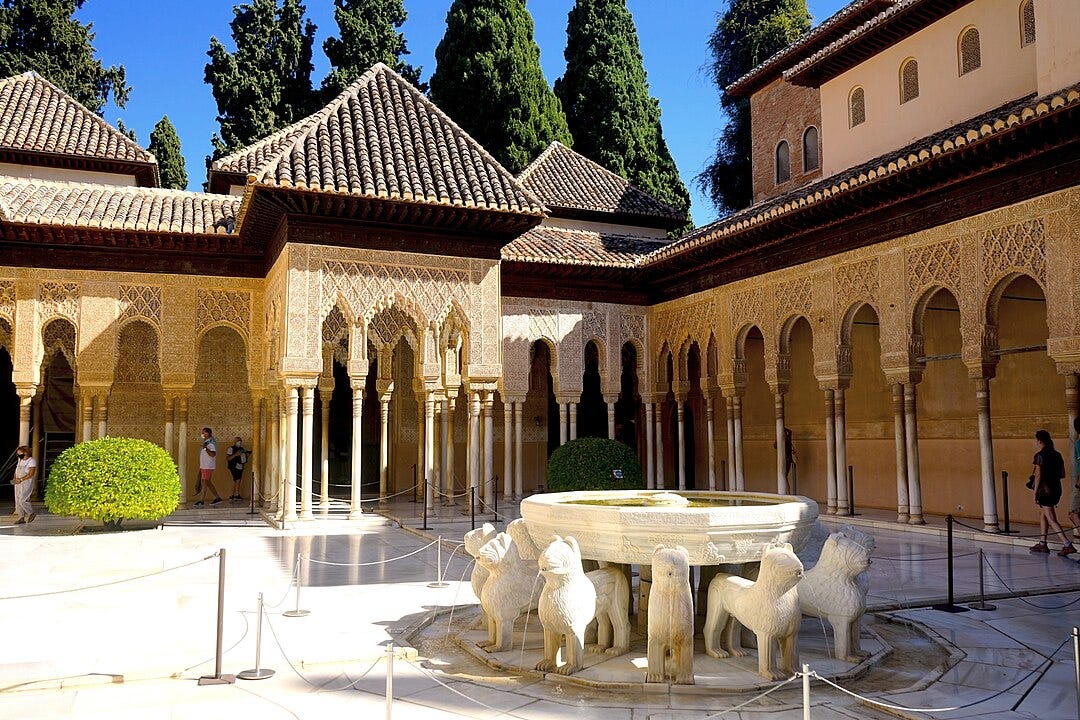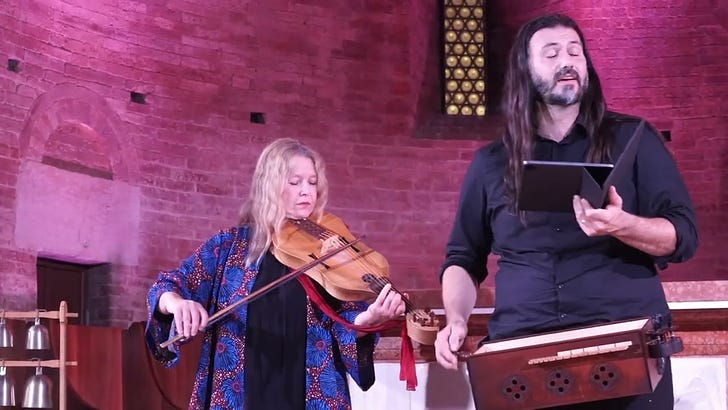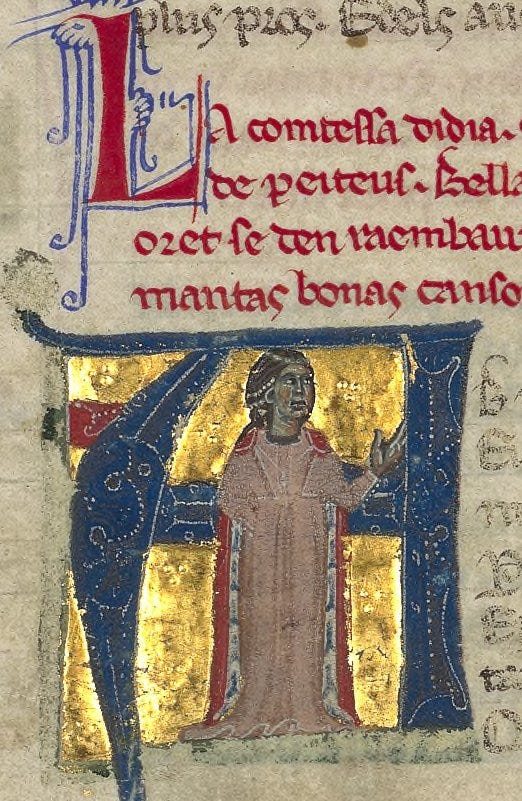Hello, and sorry for the long delay between episodes. But it’s time to return to our history of the troubadours! So far, we’ve focused heavily on the most famous troubadours, who were largely male and European. But there are definite female and Arabic influences on the troubadour tradition, and I promised you a look at that, so here we go… If you want to go back, the previous episode is here:
Female troubadours
The female troubadours, or trobairitz, are the first documented female composers of secular music. The first attested trobairitz is Tibors de Sarenom (1130-1198). Only one of her works has been found, and only the lyrics have survived; the music in the following performance, the music at least, is therefore speculative.
The known trobairitz include Alamanda de Castelnau, Azalais de Porcairagues, Maria de Ventadorn, Tibors, Castelloza, Garsenda de Proença, Gormonda de Monpeslier, and the Comtessa de Diá. We know of them through the vidas, short biographies of the troubadours, and the chansonniers, song books, that have survived from their era. They were all nobles at court—while the male troubadours might sometimes have been of humble origin, the surviving information about the trobairitz suggest they were all nobles.
In the north of France, the trouvères (poet/musician) tradition did include female composers, though none of their melodies and few of their poems have survived.
Perhaps the best-known female troubadour was the Comtessa de Dia, whom we mentioned last time. Unfortunately, the only surviving trobairitz melody or music is for the Comtessa’s A chantar. The surviving document is shown below.
As you can see, it is very sparse, just words and melodies, not even tempo or the spacing between notes. When listening to musical performances, as noted here in our last episode, much of what you hear is interpolated, or “made up”. :)
Another Beatriz, Bieiris de Romans, wrote a poem/song expressing courtly love for another woman. There is academic dispute over whether the song is in fact a lesbian poem (the composer and recipient are both known to be female), or whether other explanations are more likely.
During this era, women, nobles in particular, were expected to, and likely enjoyed, being able to perform music. Especially during Crusade years, when many of the men might be off at war, it is not surprising that they might take that opportunity to produce and document more new music.
Arabic influences
The Iberian Peninsula (Spain and the Al-Andalus) came under Muslim control in 711. They held all or parts of it until 1492 when Granada was conquered. The Muslims also ruled Sicily from 827 to 1061, when the Normans took control, and of course the cultural influences in both places lasted much longer.
By the way - did you know that the port cities of Cordoba (Spain) and Palermo, Sicily, had populations ten times the size of Rome in this era? These were big places…

The famous Alhambra was built beginning 1238 by Muhammad I Ibn al-Ahmar, the Islamic founder of the Emirate of Granada. Christian forces retook the Alhambra during the Reconquista, the period of re-conquest by crusaders, and in 1492 Christopher Columbus famously received his expedition charter from Ferdinand and Isabella. The Islamic nature of the architecture is apparent; similar influences on musical culture are to be expected. The oud, the Middle Eastern precursor to the lute, was manufactured in large quantities in the Al-Andalus region, spreading throughout Europe eventually, in the form of the lute.
Southern France, Occitania, was very near to the Islamic empire and there was certainly cross-fertilization, not to mention war.
William VIII, Richard’s great-great-grandfather, fought in the Reconquista, the Christian effort to reclaim Spain from Muslim rule. At the Battle of Barbastro, over 2,000 female slaves were captured1, many who were qiyān3, a class of enslaved female Arab singers. It is likely some were brought back to Poitiers, influencing William IX, “the first troubadour”.
There is an intriguing story of a woman of European origin who was captured, sold into slavery, returning to Iberia as a qiyān:
…female vocalist by the name of Qalam-- and Qalam means pen, like the pen you write with, in Arabic. We know that she is…of Navarese or Basque origin and that she was either sold into slavery or captured in a military campaign in Northern Spain. She was then shipped all the way across the Mediterranean to be trained in what at that point was the center of musical life in the east, which was the city of Medina. She became an accomplished singer, a lute player, recited poetry, a dancer, knew calligraphy, and even apparently shadow puppetry. And then she was eventually sold from Medina in the East back to the Iberian peninsula and then became one of the star singers in the court in Cordoba.2
If you want to dive deep into the trajectory of music from the Islamic world to Europe, check out musicologist/journalist Ted Gioia’s article on how innovation happens in music and how it is deeply influenced by migration and by lowest levels of society, usually slaves. In the case of the troubadours, I think he leans a little too hard into the qiyān influence in creating the troubadour tradition, but he’s chasing a thesis that broadly holds water.
OK let’s finish up with some music. Keeping in mind that many modern performances are interpolated from scant information about how they were performed, it is very hard not to hear the Arabic / Moorish influence on this music…
Lanquan li jorn, by Jaufré Rudel, who likely went on the Second Crusade with Eleanor of Aquitaine and Louis VI of France.
Cantigas de Santa Maria, produced and performed at the court of Alfonso X in Toledo.
In 1998, Eduardo Paniagua's Spanish group, Moroccan singer El Arabí Serghini, and the Tre Fontane Ensemble came together for an international event and formed and eight-strong "orchestra" including a female singer, singers and musicians. This concert...endeavoured to re-create an historical event, as simply as possible: the encounter of troubadours and Arabic-Andalusian musicians at the court of Alfonso X…A meeting point where numerous musical styles converged.3
This concert produced one of my personal favorites, Altas Undas (“High waves”), which makes an appearance in my novel of Richard.
That’s all for now. Next time, we’ll visit the court of Eleanor of Aquitaine, and watch the rise of Chivalry and the Arthurian tradition, driven by the troubadour tradition. And speculate on how that might have influenced Richard’s life.
https://jasurmagazine.org/ryskamp
https://afropop.org/articles/interview-dwight-reynolds-al-andalus-1-europe
http://albacarma.free.fr/2tref01.htm








